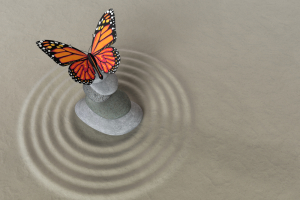 Traditional Chinese Medicine is one of the oldest healthcare systems that has been in existence for thousands of years throughout Eastern Asia such as China, Korea and Japan.
Traditional Chinese Medicine is one of the oldest healthcare systems that has been in existence for thousands of years throughout Eastern Asia such as China, Korea and Japan.
It encompasses modalities such as acupuncture, herbal medicine, cupping, moxibustion etc.
Chinese Medicine views the body as a microcosm (a miniature universe; 小宇宙) which means the human body is a part of nature but it is also an independent, and unique organism. It doesn’t separate the body from the spirit or separate the human body from nature when treating people. Therefore, Chinese Medicine takes a holistic view of every vital phenomenon, cultivates the body’s intrinsic ability to overcome diseases and does not just address the most notable symptoms.
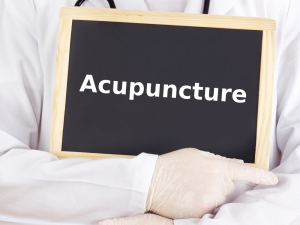 Acupuncture has been a part of traditional Chinese medicine (TCM) for thousands of years. It involves inserting fine single-use needles into specific points on the skin of the body or applying various other techniques to the acupuncture points to bring about healing. We select and stimulate specific points according to your condition to correct imbalance in the flow of Qi through the channel known as meridians. This Qi (pronounced “Chee”) can be interpreted as life force or Energy force, and circulates along the invisible network of channels known as “meridians”
Acupuncture has been a part of traditional Chinese medicine (TCM) for thousands of years. It involves inserting fine single-use needles into specific points on the skin of the body or applying various other techniques to the acupuncture points to bring about healing. We select and stimulate specific points according to your condition to correct imbalance in the flow of Qi through the channel known as meridians. This Qi (pronounced “Chee”) can be interpreted as life force or Energy force, and circulates along the invisible network of channels known as “meridians”
There are 360 acupuncture points on the body, and they form 12 regular meridians. A meridian can be like a railway and an acupuncture point is like a train station. A train cannot operate if a train station is under works or if there is blockage by something on the railway. When Qi flow in the meridian is obstructed, the body may lose physiological balance or harmony, and disease may follow. This Qi disruption can result from inappropriate lifestyles such as excessive stress, overwork, poor diet, weather and environmental conditions. In these cases, acupuncture could work very effectively. By needling into specific points, the Qi of flow could be restored and promoted, and the disruption can be corrected.
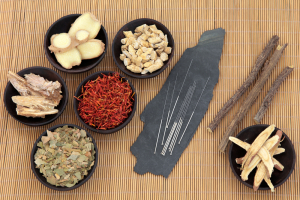 Herbal medicine, together with acupuncture, are like both sides of a birds feather, which means that they are mainstream in Chinese medicine, and we cannot discuss one without the other when discussing Chinese medicine. Herbal medicine is defined as a naturally occurring drug obtained from plants, animals or minerals, and they are dried naturally or processed for therapeutic purpose. Even though animals and minerals are used in Chinese medicine, because most of the clinically used medicines are from plants, it is called “herbal medicine”.
Herbal medicine, together with acupuncture, are like both sides of a birds feather, which means that they are mainstream in Chinese medicine, and we cannot discuss one without the other when discussing Chinese medicine. Herbal medicine is defined as a naturally occurring drug obtained from plants, animals or minerals, and they are dried naturally or processed for therapeutic purpose. Even though animals and minerals are used in Chinese medicine, because most of the clinically used medicines are from plants, it is called “herbal medicine”.
Herbal medicine is designed to treat the underlying causes of disease in a client. Instead of only looking at the signs and symptoms and then treating the disease, we, the Chinese medicine practitioner, looks at the whole picture of a client including lifestyle, diet, physical and emotional stressors, in order to prescribe the right treatment.
Once the cause of a condition is discovered, herbs are prescribed to restore the body’s natural balance. Many pharmaceutical companies use the active ingredient found in herbs in their products or even artificially synthesise the active ingredients, and claim that it treats a clinical condition or illness. However, it is important to use the whole plant instead of using an active ingredient because by using naturally-occurring, clean and well-prepared herbs, the many ingredients contained in the herb (the whole plant) work together and make the herb safe and as effective as possible, creating a ‘synergy effect’. Therefore, in most clinical conditions, we prescribe herbal medicine as a combination of different herbs, and the different herbs interact to produce the most beneficial effect.
Herbal medicine for oral administration can be prepared in the form of a decoction, powder and tablets in BON clinic. Decoctions are made by boiling a herbal combination as prescribed, to extract the active ingredients. The liquid is strained and can be taken either hot or cold.
Powdered herbs are made from dried raw herbs ground into powder and tablets can be made from powdered herbs.
In our BON clinic, creams for external use are available for specific skin disorders such as atopic dermatitis (eczema), psoriasis. Tinctures for conditions such as hay fever and acute/chronic rhinitis are also available at the clinic.
Cupping is the term applied to a technique that uses small glass cups or bamboo jars as suction devices that are placed on the skin. In order to create suction, a small flame is created on an alcohol swab or a cotton ball soaked in alcohol. The flame is then put into the cup to make a negative pressure and is then placed immediately against the skin. Flames are never used near the skin and are not lit throughout the process of cupping, but rather, are a means to create the heat that causes the suction within the small cups.
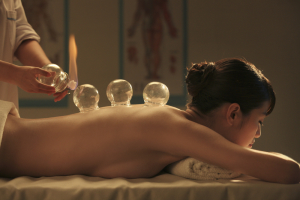 The suction in the cups causes the skin and superficial muscle layer to be lightly drawn into the cup. Cupping is much like the inverse of massage – rather than applying pressure to muscles, it uses gentle pressure to pull them upward. For most patients, this is a particularly relaxing and relieving sensation, similar to acupressure that targets acupuncture points as well as painful body parts, and is well known to provide relief through pressure.
The suction in the cups causes the skin and superficial muscle layer to be lightly drawn into the cup. Cupping is much like the inverse of massage – rather than applying pressure to muscles, it uses gentle pressure to pull them upward. For most patients, this is a particularly relaxing and relieving sensation, similar to acupressure that targets acupuncture points as well as painful body parts, and is well known to provide relief through pressure.
Generally, cupping is combined with acupuncture in one treatment, but it can also be used alone. The suction and negative pressure provided by cupping can loosen muscles, encourage blood flow, and sedate the nervous system. Cupping could be used to relieve back and neck pains, stiff muscles, anxiety, fatigue, migraines, rheumatism, and etc.
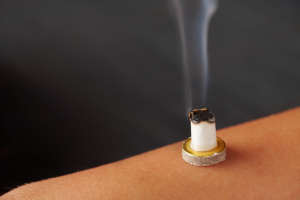 Moxibustion is a traditional Chinese medicine technique that involves the burning of mugwort, a small, spongy herb, to facilitate healing. Moxibustion has been used throughout Asia for thousands of years; in fact, the actual Chinese characterfor acupuncture(鍼灸), translated literally, means “acupuncture(鍼)-moxibustion()灸.” The purpose of moxibustion, as with most forms of traditional Chinese medicine, is to strengthen the blood, stimulate the flow of qi (life force), and maintain general health.
Moxibustion is a traditional Chinese medicine technique that involves the burning of mugwort, a small, spongy herb, to facilitate healing. Moxibustion has been used throughout Asia for thousands of years; in fact, the actual Chinese characterfor acupuncture(鍼灸), translated literally, means “acupuncture(鍼)-moxibustion()灸.” The purpose of moxibustion, as with most forms of traditional Chinese medicine, is to strengthen the blood, stimulate the flow of qi (life force), and maintain general health.
In traditional Chinese medicine, moxibustion is used on people who have a cold or stagnant condition. The burning of moxa is believed to expel cold and warm the meridians, which leads to smoother flow of blood and qi.
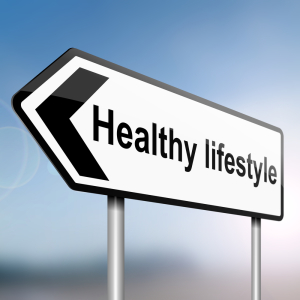 The initial visit to this clinic involves a thorough consultation to acquaint the practitioner with your unique health conditions, and to collect physiological and medical information. For this reason, the initial consultation generally takes about 1 hour. As Chinese Medicine has a holistic approach to health, we do consider all of the contributing factors of any symptoms and signs in the body, your lifestyle and observing tongue etc, to arrive at a correct individualised diagnosis. It may be involved with physical examination such as abdominal palpation, tapping and rotating of the affected area with pain, to provide the appropriate treatment for your condition. After making a final diagnosis through consultation for your health problem, the treatment session is often a combination of acupuncture, herbal medicine, cupping, moxibustion, nutrient advice and other therapeutic instruction like exercise, energetic and stress reduction techniques, in order to enhance therapeutic effectiveness.
The initial visit to this clinic involves a thorough consultation to acquaint the practitioner with your unique health conditions, and to collect physiological and medical information. For this reason, the initial consultation generally takes about 1 hour. As Chinese Medicine has a holistic approach to health, we do consider all of the contributing factors of any symptoms and signs in the body, your lifestyle and observing tongue etc, to arrive at a correct individualised diagnosis. It may be involved with physical examination such as abdominal palpation, tapping and rotating of the affected area with pain, to provide the appropriate treatment for your condition. After making a final diagnosis through consultation for your health problem, the treatment session is often a combination of acupuncture, herbal medicine, cupping, moxibustion, nutrient advice and other therapeutic instruction like exercise, energetic and stress reduction techniques, in order to enhance therapeutic effectiveness.
The course of treatment will be one or many, and each person is different from another. It depends on the severity of the condition and the duration that the condition has existed.
From a Chinese Medicine prospective, the same disease can be treated differently, and a different disease can applied with the same treatment. For example, two migraine patients can have different treatments applied because even though they have same medical condition, they would have a different onset of problems. In Chinese Medicine, each patient is an individual with a unique health problem. Therefore we, BON clinic, will provide an optimised health care service for each individual client, based on comprehensive clinical information gained from the consultation.